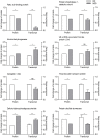Describing the Diapause-Preparatory Proteome of the Beetle Colaphellus bowringi and Identifying Candidates Affecting Lipid Accumulation Using Isobaric Tags for Mass Spectrometry-Based Proteome Quantification (iTRAQ)
- PMID: 28491041
- PMCID: PMC5405119
- DOI: 10.3389/fphys.2017.00251
Describing the Diapause-Preparatory Proteome of the Beetle Colaphellus bowringi and Identifying Candidates Affecting Lipid Accumulation Using Isobaric Tags for Mass Spectrometry-Based Proteome Quantification (iTRAQ)
Abstract
Prior to entering diapause, insects must prepare themselves physiologically to withstand the stresses of arresting their development for a lengthy period. While studies describing the biochemical and cellular milieu of the maintenance phase of diapause are accumulating, few studies have taken an "omics" approach to describing molecular events during the diapause preparatory phase. We used isobaric tags and mass spectrometry (iTRAQ) to quantitatively compare the expression profiles of proteins identified during the onset of diapause preparation phase in the heads of adult female cabbage beetles, Colaphellus bowringi. A total of 3,175 proteins were identified, 297 of which were differentially expressed between diapause-destined and non-diapause-destined female adults and could therefore be involved in diapause preparation in this species. Comparison of identified proteins with protein function databases shows that many of these differentially expressed proteins enhanced in diapause destined beetles are involved in energy production and conversion, carbohydrate metabolism and transport, and lipid metabolism. Further hand annotation of differentially abundant peptides nominates several associated with stress hardiness, including HSPs and antioxidants, as well as neural development. In contrast, non-diapause destined beetles show substantial increases in cuticle proteins, suggesting additional post-emergence growth. Using RNA interference to silence a fatty acid-binding protein (FABP) that was highly abundant in the head of diapause-destined females prevented the accumulation of lipids in the fat body, a common product of diapause preparation in this species and others. Surprisingly, RNAi against the FABP also affected the transcript abundance of several heat shock proteins. These results suggest that the identified differentially expressed proteins that play vital roles in lipid metabolism may also contribute somehow to enhanced hardiness to environmental stress that is characteristic of diapause.
Keywords: diapause preparation; fatty acid-binding protein; iTRAQ; lipid metabolism; proteomics; stress resistance.
Figures





Similar articles
-
Absence of juvenile hormone signalling regulates the dynamic expression profiles of nutritional metabolism genes during diapause preparation in the cabbage beetle Colaphellus bowringi.Insect Mol Biol. 2017 Oct;26(5):530-542. doi: 10.1111/imb.12316. Epub 2017 May 20. Insect Mol Biol. 2017. PMID: 28544235
-
Circadian clock genes link photoperiodic signals to lipid accumulation during diapause preparation in the diapause-destined female cabbage beetles Colaphellus bowringi.Insect Biochem Mol Biol. 2019 Jan;104:1-10. doi: 10.1016/j.ibmb.2018.11.001. Epub 2018 Nov 10. Insect Biochem Mol Biol. 2019. PMID: 30423421
-
The limited regulatory roles of juvenile hormone degradation pathways in reproductive diapause preparation of the cabbage beetle, Colaphellus bowringi.J Insect Physiol. 2019 Nov-Dec;119:103967. doi: 10.1016/j.jinsphys.2019.103967. Epub 2019 Oct 18. J Insect Physiol. 2019. PMID: 31634472
-
Fatty acid synthase 2 contributes to diapause preparation in a beetle by regulating lipid accumulation and stress tolerance genes expression.Sci Rep. 2017 Jan 10;7:40509. doi: 10.1038/srep40509. Sci Rep. 2017. PMID: 28071706 Free PMC article.
-
Juvenile hormone facilitates the antagonism between adult reproduction and diapause through the methoprene-tolerant gene in the female Colaphellus bowringi.Insect Biochem Mol Biol. 2016 Jul;74:50-60. doi: 10.1016/j.ibmb.2016.05.004. Epub 2016 May 12. Insect Biochem Mol Biol. 2016. PMID: 27180724
Cited by
-
Development and diapause induction of the Indian meal moth, Plodia interpunctella (Hübner) (Lepidoptera: Pyralidae) at different photoperiods.Sci Rep. 2020 Sep 7;10(1):14707. doi: 10.1038/s41598-020-71659-7. Sci Rep. 2020. PMID: 32895417 Free PMC article.
-
Changes in Energy Metabolism Trigger Pupal Diapause Transition of Bactrocera minax After 20-Hydroxyecdysone Application.Front Physiol. 2019 Oct 30;10:1288. doi: 10.3389/fphys.2019.01288. eCollection 2019. Front Physiol. 2019. PMID: 31736767 Free PMC article.
-
Comparative Transcriptome and iTRAQ Proteome Analyses Reveal the Mechanisms of Diapause in Aphidius gifuensis Ashmead (Hymenoptera: Aphidiidae).Front Physiol. 2018 Nov 30;9:1697. doi: 10.3389/fphys.2018.01697. eCollection 2018. Front Physiol. 2018. PMID: 30555341 Free PMC article.
-
Comparative proteomics provides insights into diapause program of Bactrocera minax (Diptera: Tephritidae).PLoS One. 2020 Dec 31;15(12):e0244493. doi: 10.1371/journal.pone.0244493. eCollection 2020. PLoS One. 2020. PMID: 33382763 Free PMC article.
-
Doxorubicin resistance in breast cancer is mediated via the activation of FABP5/PPARγ and CaMKII signaling pathway.Front Pharmacol. 2023 Jul 19;14:1150861. doi: 10.3389/fphar.2023.1150861. eCollection 2023. Front Pharmacol. 2023. PMID: 37538178 Free PMC article.
References
LinkOut - more resources
Full Text Sources
Other Literature Sources

